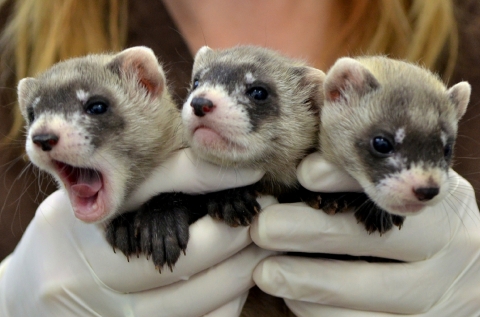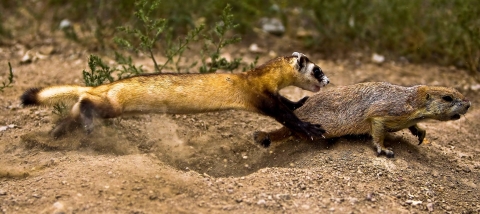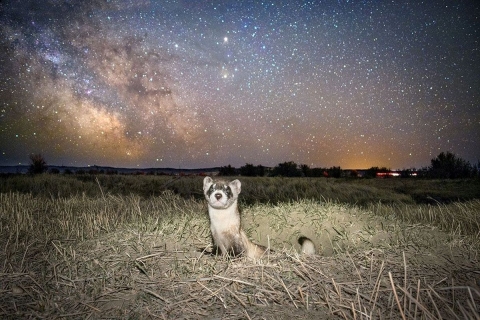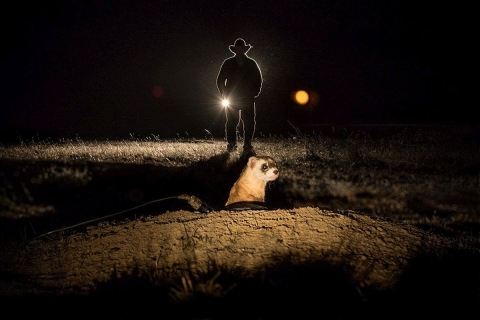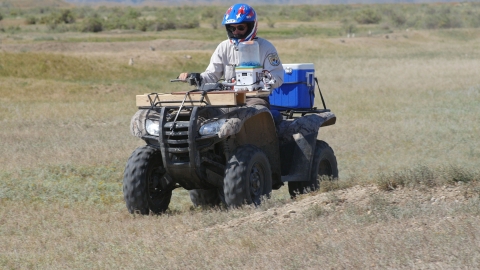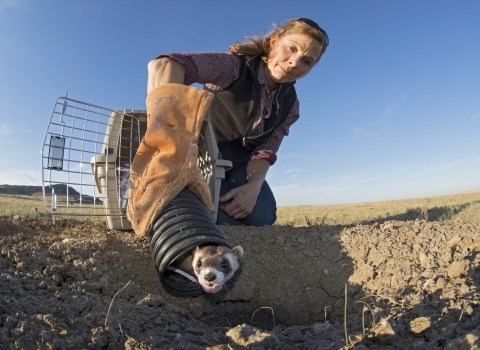If Hollywood were scripting a wildlife drama, it could hardly have more compelling elements than this one. Consider:
- A charismatic, wily hero. You might even call it cute.
- A fearsome villain. Just the word plague makes us cringe.
- Suspense. The ending could be a cliff-hanger.
- Whiz-bang technology. Did we mention drones?
- Something offbeat. How about peanut butter? That’s in there, too.
The true story is about efforts to save the endangered black-footed ferret, a wiry mammal once widespread across the Great Plains from Mexico to Canada. Then European settlers introduced diseases, plowed grasslands into crop fields and helped poison their prey. By the 1950s, ferrets appeared to be extinct.
In 1964 biologists found a small population of black-footed ferrets in South Dakota. But the wild ferrets did poorly and soon died. So did the ferrets that scientists captured in hopes of breeding them in captivity.
When another small population was discovered in 1981, biologists got a rare second chance. Since then, the U.S. Fish and Wildlife Service and a slew of federal, state, tribal and nonprofit partners have joined efforts to try to save the species. The coalition captive-breeds the ferrets at five zoos as well as the Service’s National Black-Footed Ferret Conservation Center in Colorado. Scientists reintroduce captive-bred ferrets at selected western sites, including Canada and Mexico, monitor them and try to reduce threats facing the species.
The greatest threat is sylvatic plague.
The disease, spread by fleas, is a devious enemy.
“We’re not worried so much about plague killing ferrets. We’re worried about plague killing their primary food source – the prairie dog,” says Dave Lucas, project leader at Rocky Mountain Arsenal National Wildlife Refuge near Denver. Black-footed ferrets were reintroduced to the refuge in October 2015. “Plague can come in and kill entire prairie dog colonies. It has happened here. If that happens, there’s nothing for black-footed ferrets to eat.”
It follows that plague management is a primary goal at ferret recovery sites. Lately, it’s taking some innovative forms.
UL Bend National Wildlife Refuge in Montana has served as the staging ground for some of the most innovative work in the fight against plague. From 1994, when black-footed ferret reIntroductions began there, until 2008, biologists periodically dusted prairie dog burrows with a flea-killing powder. The goal was to stop plague cold. But dusting provided only limited protection and was expensive and labor-intensive. Scientists needed a better way.
What if, instead of trying to wipe out plague, scientists could immunize prairie dogs against it? So began the idea for spreading oral vaccine pellets, laced with peanut butter to entice prairie dogs to eat them.
The vaccine was developed by U.S. Geological Survey research epizootiologist Tonie Rocke. Tests show the pellets are safe to other animals that eat them. Support from World Wildlife Fund’s Innovation Grants has been instrumental in developing vaccine distribution systems.
U.S. Fish and Wildlife Service supervisory wildlife biologist Randy Matchett is part of a study of 12 sites in 7 states evaluating the technique’s effectiveness. He’s cautiously optimistic.
“Oral plague vaccine seems to help in reducing prairie dog mortality,” he says. “We have learned how to mass-produce vaccine bait pellets, and we’re working to develop a distribution system that is practical and affordable.”
That means spreading the pellets automatically from all-terrain vehicles or shooting them from drones. Matchett and his partners have been innovators in refining the process.
Working on ferret recovery poses challenges.
For starters, says Matchett, “it’s all night work. Ferrets are very secretive. They’re only out at night. They’re hard to find.”
Each fall, recovery team members catch and tag wild-born kits. Before the animals are released, half an hour later, they’re also vaccinated against plague and canine distemper. Sounds straightforward, right? Unless you’ve ever tried to catch one.
Plan on “driving around in an ATV or truck with a spotlight all night long until you find one,” says Matchett. Then place a trap and wait – and wait – until it goes into the trap. Repeat.
Watch your hands. “You want to handle [ferrets] politely,” says Lucas. “They have the largest canines of any mammals in North America proportional to their body size, and they will bite.”
Got all your ferrets? You’re not done. Matchett explains: “For those two vaccines to be most effective, you have to catch them once more 30 days later and vaccinate them again.”
At some point, you might ask: Why go to so much trouble? Why devote so much effort to saving a species most Americans will never see firsthand?
At Rocky Mountain Refuge, Lucas offers an answer: “Number 1, most of us believe black-footed ferrets were endangered because of human activities. Humans killed off most ferret habitat, used poisons used to kill prairie dogs, introduced disease … Therefore we have a responsibility to recover this species. These animals have a right to exist on the prairie, and we have the job to make that possible.”
What’s more, he says, “this is a missing piece in the ecosystem. Ecosystems work best when all pieces of puzzle are there.” Just as the return of wolves to Yellowstone ecosystem helped restore balance there, he predicts the return of black-footed ferrets will make the prairie more resilient. “We’re adding a predator back to the equation that should have been there.”
Field trials are under way to deliver oral vaccine pellets to prairie dogs via drones, where conditions permit. Remote places like UL Bend Refuge make good test sites.
The aim is to drop the one-gram (.04-ounce) pellets in a grid – one every 30 feet, 50 pellets per acre – “so that one hog prairie dog doesn’t get them all,” says Matchett. If the pellets reach three-quarters of the prairie dogs, the whole colony benefits.
Drones can’t be used at Rocky Mountain Arsenal Refuge because it’s near the Denver airport. There, pellet dispensing is done by a device mounted on an ATV.
Instead of covering 6 acres per hour, as you would on foot, the device ramps that up to 60 acres. “We’ve set ourselves a goal to treat over 300 acres per hour,” says Matchett. At that rate, it would take 10 hours to treat the Denver refuge’s 3,000 acres, and 7 hours or so to treat UL Bend’s 2,000 acres.
See a short video about the vaccine distribution.
Additional Challenges
Ferrets face more than biological challenges. There are social challenges as well.
Historically, ranchers and farmers have not been interested in keeping a healthy supply of prairie dogs around; some people poison prairie dogs rather than have them compete with cattle for forage or dig holes that trip up livestock or farm equipment.
But some private landowners are revising their views on ferrets. In Colorado and Wyoming, some ranchers have signed Safe Harbor Agreements permitting reintroductions of black-footed ferrets on their land. The agreements let landowners continue normal ranching operations and protect them from prosecution if endangered ferrets are accidentally killed in the process. The pacts also offer financial assistance for added costs.
Meanwhile, exactly how ferret recovery will impact prairie dogs isn’t known.
“We’re very curious what effect black-footed ferrets will have on prairie dog populations” at Rocky Mountain Arsenal Refuge, says Lucas. “Prairie dogs were overpopulated here before ferret reintroduction … The population is going down.” Ferrets are good hunters, with super-high metabolisms, he says: “A male ferret eats on average 100 prairie dogs a year. A female eats 150.”
So, if ferrets thrive, will they out-eat their food supply? Not likely, says Lucas. He does the math. “You figure conservatively there are 30 prairie dogs per acre times 3,000 acres that the refuge is sitting on. That’s 90,000 prairie dogs. Even if the refuge’s 50 black-footed ferrets eat 150 prairie dogs a year, that’s 7,500 prairie dogs. That’s not even 10 percent.”
It’s clear that ferret recovery generates enthusiasm on both refuges.
“The story is pretty darned cool,” says Lucas. “There aren’t a ton of species where refuges are both hosting such a large proportion of the animals and doing this type of exciting hands-on recovery work.”
What’s more, the ferrets’ fan base is growing.
At Rocky Mountain Arsenal Refuge, some visitors have even managed to snap photos of the elusive animals and post them online. “The public is getting pictures of these ferrets that once only scientists could get,” marvels Lucas. “That’s a success. Visitors have spotted them in daytime off Wildlife Drive. I never thought anybody in the public would ever see one.”
See a Flickr photo album on black-footed ferrets.
That doesn’t mean the future for black-footed ferrets is secure.
Only an estimated 300 survive in the wild, across 28 reintroduction sites.
Plague is a formidable enemy, and vaccination efforts are in their early stages.
But if black-footed ferrets can be recovered, these folks are determined to do the job.
“We are truly moving this program along, because we are the premier land management agency with the purpose of wildlife conservation,” says Lucas, of the U.S Fish and Wildlife Service’s efforts. “Through science and learning, we may get there with these guys.”
More information:
Black-footed ferrets on Facebook

